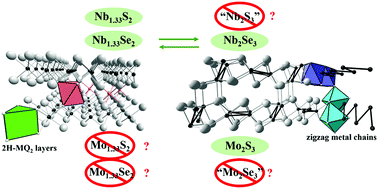Theoretical and experimental comparative study of the stability and phase transformations of sesquichalcogenides M2Q3 (M = Nb, Mo; Q = S, Se)†
Abstract
The extensive family of transition metal chalcogenides has been comprehensively investigated owing to their diverse useful properties. However, even among them, there are ones that have received comparatively less attention; in particular, these are molybdenum and niobium sulfides and selenides with the composition of M : Q = 2 : 3 (M = Mo, Nb; Q = S, Se). Mo or Nb chalcogenides with this stoichiometry may adopt one of two structures: (i) sesquichalcogenides M2Q3, where important structural elements are infinite metal chains, or (ii) self-intercalated compounds M1.33Q2, in which extra M atoms are inserted between MQ2 layers. Depending on the M–Q combination, in practice, either none, one, or both of them may exist. The reasons for chemical dissimilarity in the series of seemingly related compounds haven’t been addressed until the present work. Here, we present the first generalized comparative study of these chalcogenides by quantum-chemical computations verified by laboratory experiments. High-temperature phases of Mo2S3 and Nb2Se3 may be stably isolated at room temperature, while “Nb2S3” and “Mo2Se3” had not been obtained, nor were they expected to exist from DFT data. The structure-determining motifs of sesquichalcogenides M2Q3 are metallic chains, and thus, apparently, if metal's electron deficiency (or excess) prevents the formation of M–M chains, then the M2Q3-type structure cannot form. If the metal has an adequate electron density and the structure does form at high temperature (as it happens for Mo2S3 and Nb2Se3), then it can be kinetically stabilized by quenching, and stored under laboratory conditions for long times. However, if Nb2Se3 is left to cool down slowly, it undergoes phase transition to iso-stoichiometric intercalate Nb1.333Se2, in good agreement with DFT predictions of the close values of their free energies. Isostructural intercalate Nb1.333S2 is found to be the only experimental product in the Nb–S system, in full accordance with DFT prediction. Effective stabilization of self-intercalated phases is provided by significant charge transfer from intercalated Nb atoms to the NbQ2 layers, as confirmed by DFT. The obtained data may serve to get insight into polymorphism of some less-studied transition metal chalcogenides and to promote their use for future functional materials.



 Please wait while we load your content...
Please wait while we load your content...